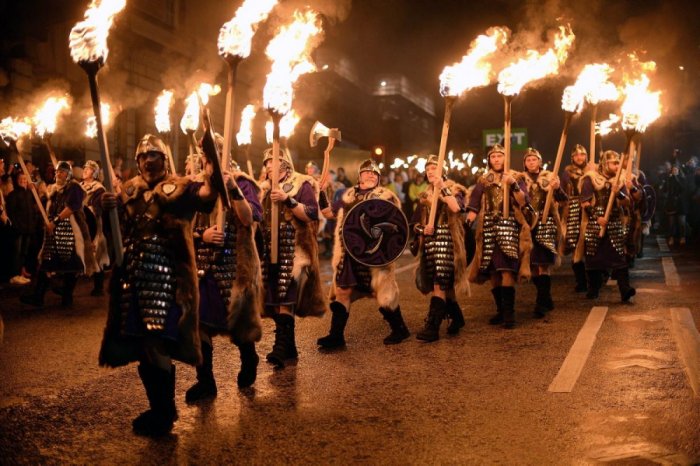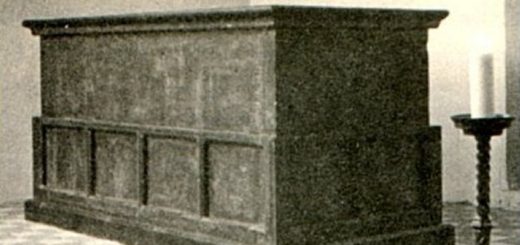Hogmanay: Scotland’s New Year Celebration Inherited From The Vikings
On December 31, people in Scotland celebrate Hogmanay. It’s a very old tradition and the celebrations continue into the first couple of days of January. Many local areas have their own customs when it comes to celebrating Hogmanay and they are all very spectacular!
Traditional Hogmanay celebrations were originally brought to Scotland by the invading Vikings in the early 8th and 9th centuries.

New Year is still called Yules, deriving from the Scandinavian word for the midwinter festival of Yule. The long history of Viking and Norse settlement in Scotland is the reason why these two nations share many ancient traditions.
The origin of the word “Hogmanay” is unknown. A number of theories have been put forward and opinions differ as to whether the word originated from the Gaelic oge maidne (“New Morning”), Anglo-Saxon Haleg Monath (“Holy Month”), or Norman French word hoguinané, which was derived from the Old French anguillanneuf (“gift at New Year”).
Hogmanay procession. Image credit: Visit Scotland
It has also been suggested that it came from the French au gui mener (“lead to the mistletoe”) or a Flemish combo hoog (“high” or “great”), min (“love” or “affection”) and dag (“day”).
Hogmanay consists of several ancient traditions that are still practiced today.
First footing is a Hogmanay tradition still practiced across Scotland.
After the stroke of midnight, neighbors visit each other bringing gifts such as shortbread or black bun, a kind of fruit cake. The visitor, in turn, is offered a small whisky. To ensure good luck for the house the first foot should be a dark male.
The dark male bit is believed to be a throwback to the Viking days, when a big blonde or redhead stranger arriving on your door step with a big axe meant big trouble, and probably not a very happy New Year!
Before the Hohmanay can begin, families must clean the house and take out the ashes from the fireplace. The house must be ready for the New Year. There is also the superstition to clear all your debts before “the bells” at midnight. This is without doubt easier said than done these days.
Immediately after midnight it is traditional to sing Robert Burns’ “For Auld Lang Syne”.
The Hogmanay celebrations vary slightly in different areas of Scotland. In addition to national observance, many local areas have their own customs when it comes to celebrating Hogmanay.
In Edinburgh and throughout many cities in Scotland you can see magnificent firework display and torchlight processions.
The traditional New Year ceremony would involve people dressing up in the hides of cattle and running around the village being hit by sticks.
The festivities would also include the lighting of bonfires, rolling blazing tar barrels down the hill and tossing torches. Animal hide was also wrapped around sticks and ignited which produced a smoke that was believed to be very effective to ward off evil spirits. The smoking stick was also known as a Hogmanay.
Some of these customs do continue, especially in the small, older communities in the Highlands and Islands of Scotland where tradition, along with language and dialect are kept alive and well.
On the Isle of Lewis, in the Outer Hebrides, the young boys form themselves into opposing bands, the leader of each wears a sheep skin, while a member carries a sack. The bands move through the village from house to house reciting a Gaelic rhyme.
On being invited inside, the leader walks clockwise around the fire, while everyone hits the skin with sticks. The boys would be given some bannocks – fruit buns – for their sack before moving on to the next house.
One of the most spectacular Fire ceremonies takes place in Stonehaven, just south of Aberdeen on the North East coast. Here, the locals make giant balls of tar, paper and chicken wire. Weighing up to 20 pounds, these giant fireballs are lit and swung around on five feet long metal poles, requiring 60 men to carry them as they march up and down the High Street.
At the end of the festival, any balls still on fire are cast into the water. The origin of the pre-Christian custom is believed to be linked to the Winter Solstice of late December with the fireballs signifying the power of the sun, to purify the world by consuming evil spirits.
For around 400 years, from the end of the 17th century to the 1950s, Scots were not allowed to celebrate Christmas. The reason for this has its roots in the Protestant Reformation when the Kirk portrayed Christmas as a Popish or Catholic feast and therefore had to be banned.
Many Scots had to work over Christmas and their winter solstice holiday was therefore at New Year when family and friends gathered for a party and exchange presents, especially for the children, which came to be called Hogmanay.
During Hogmanay celebrations fire is considered a powerful and important symbol.
The flame and fire at Hogmanay symbolises many things. The bringing of the light of knowledge from one year to the next, lighting the way into the next uncharted century, putting behind you the darkness past, but carrying forward its sacred flame of hope and enlightenment to a better parish, and in this day, a new fresh year, burning away of the old to make space for the new.
If you enjoyed celebrating Hogmanay and you want to experience another great Scottish festival, then head to Shetland Islands the incredible Up Helly Aa Festival is celebrated annually. During the Up Helly Aa festival in Lerwick, Shetland Islands one can experience the sacrifice of a longship. The annual festival began in 1870.
It celebrates the influence of the Scandinavian Vikings in the Shetland Islands. Shetland and neighboring island Orkney were ruled by the Norse for about 500 years until they became part of Scotland in 1468. Almost half of all people on Shetland today have Viking ancestry.
Written by Ellen Lloyd – AncientPages.com
Copyright © AncientPages.com & Ellen Lloyd All rights reserved. This material may not be published, broadcast, rewritten or redistributed in whole or part without the express written permission of AncientPages.com and Ellen Lloyd
About the author:Ellen Lloyd – is the owner of AncientPages.com and an author who has spent decades researching ancient mysteries, myths, legends and sacred texts, but she is also very interested in astronomy, astrobiology and science in general



 Creators of mankind
Creators of mankind Description of “Tall white aliens”
Description of “Tall white aliens” Where they came from?
Where they came from? About hostile civilizations
About hostile civilizations The war for the Earth
The war for the Earth “Tall white aliens” about eternal life
“Tall white aliens” about eternal life Video: “Nordic aliens”
Video: “Nordic aliens” Aliens
Aliens Alien encounters
Alien encounters The aliens base
The aliens base UFO
UFO Technology UFO
Technology UFO Underground civilization
Underground civilization Ancient alien artifacts
Ancient alien artifacts Military and UFO
Military and UFO Mysteries and hypotheses
Mysteries and hypotheses Scientific facts
Scientific facts


















